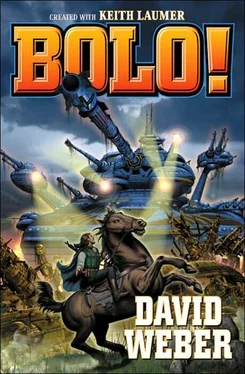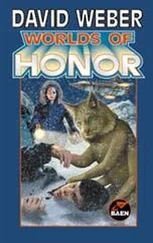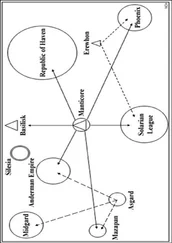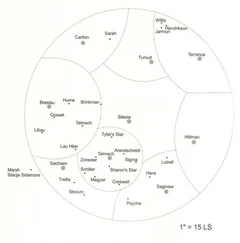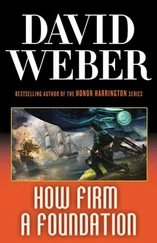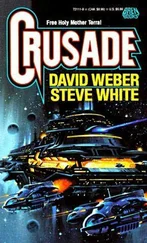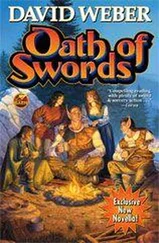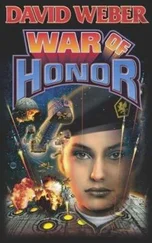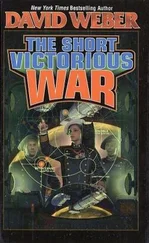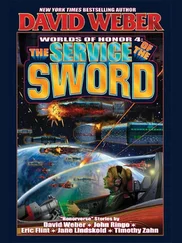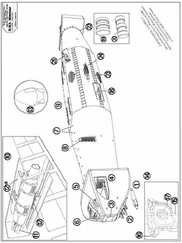“Not to destroy us?” he half-whispered.
“That is correct,” Shiva replied.
“But—” Tharsk cleared his throat. “We cannot leave, Bolo,” he said with a certain bleak pride. “I won’t hide that from you. Would you have me believe your commander would actually allow us to live on the same planet with his own people?”
“He would.”
“Then he must be mad,” Tharsk said simply. “After all we have done to one another, all the death and ruin… No, Bolo. The risk would be too great for him to accept.”
“There is no risk to him,” Shiva said flatly. “I do not wish to destroy you, but I lack neither the capability nor the will to do so at need. And never forget, Commander Tharsk Na-Mahrkan, that my overriding function is the protection of the Human race and its allies.”
“Then what are you offering us?” Tharsk sounded puzzled, and Jackson held his breath as Shiva replied.
“Nothing except your life… and the lives of your people,” the Bolo said quietly. “There are four times as many Humans as Melconians on this world. They have established farms and towns and steadings; you have none of those things. It will require all your resources and efforts simply to survive, with nothing left over to attack the Humans who are already here, but they will leave you in peace so long as you leave them so. And if you do not leave them in peace, then, Commander, I will destroy you.”
“You would make us their slaves?” Tharsk demanded.
“No, Commander. I would make you their neighbors.” The Melconian made a sound of scornful disbelief, and Shiva went on calmly. “For all you know, yours are the only Melconians left in the galaxy, and the Humans on this world are the only surviving Humans, as well. Leave them in peace. Learn to live with them, and my Commander will make me the guardian of the peace between you, not as slaves or masters, but simply as people.”
“But—” Tharsk began, but Shiva cut him off.
“Humans have a teaching: to everything there is a time, Tharsk Na-Mahrkan, and this is the time to let the killing end, time for your race and the one which built me to live. We have killed more than enough, your people and I, and I am weary of it. Let me be the final warrior of the Final War… and let that war end here.”
The Final War saw the Concordiat of Man and the Melconian Empire end in fire and death. The light of civilization was extinguished across an entire galactic arm, and the scars of that war—the planets with no life to this very day—are grim and terrible reminders of the unspeakable things two highly advanced cultures did to one another out of fear and hate… and stupidity.
But a star-traveling species is hard to exterminate. Here and there, pockets of life remained, some Human, some Melconian, and survivors clawed their way through the Long Night. They became farmers once more, sometimes even hunter-gatherers, denied the stars which once had been their toys, yet they never forgot. And slowly, ever so slowly, they learned to reach once more for the heavens.
Our own New Republic was one of the first successor states to reclaim the stars, but deep inside, we were afraid. Afraid some fragment of the Melconian Empire still lived, to resume the war and crush all that we had so painfully regained.
Until, that is, we reached the Deveraux System and discovered a thriving colony there, emplaced by the Star Union of Ararat a half-century earlier and administered by Governor Stanfield Na-Harak and his military commander, Commodore Tharsk Fordham. For two hundred standard years now, the Union has been the Republic’s staunch ally and economic partner. We have defended one another against common foes, traded with one another, and learned much from one another, yet on that long ago day of first contact, our survey officers were stunned to discover Melconians and Humans living together as fellow citizens. Our own memories and fears had prepared us to imagine almost anything except a culture in which the ancient enemies who had destroyed a galaxy were friends, comrades—even adoptive members of one another’s clans.
We asked them how it had happened, of course, and Governor Stanfield referred us to their capital world of Ararat, where Bolo XXXIII/D-1097-SHV, Speaker Emeritus of the Union Parliament, gave us the simplest answer of all.
“It was time,” he said… and it was.
– Professor Felix Hermes, Ph.D. From Bolos in Their Own Words New Republic University Press, 4029
A Brief Technical History of the Bolo From Bolos in Their Own Words
Prof. Felix Hermes, Ph.D., Laumer Chair of Military History
New Republic University Press
(c) 4029
The Bolo’s role as humanity’s protector and preserver after the Human-Melconian conflict is, of course, known to all citizens of the New Republic. So much knowledge—historical, as well as technological—was lost during the Long Night, however, that the Bolo’s earlier history is, at best, fragmentary. Much of what we do know we owe to the tireless activities of the Laumer Institute and its founder, yet there is much confusion in the Institute’s records. As just one example, Bolo DAK, savior of the Noufrench and Bayerische colonists of Neu Europa, is identified as a Mark XVI when, on the evidence of its demonstrated capabilities, it must in fact have been at least a Mark XXV. Such confusion is no doubt unavoidable, given the destruction of so many primary sources and the fragmentary evidence upon which the Institute was forced to rely.
It was possible to assemble the material in this monograph, which confirms much of the Institute’s original work, corrects some of the inevitable errors in chronology, and also breaks new ground, only with the generous assistance of Jenny (Bolo XXXIII/D-1005-JNE), the senior surviving Bolo assigned to the Old Concordiat’s Artois Sector. Jenny, the protector of our own capital world of Central during the Long Night, has very kindly made the contents of her Technical Support and Historical memories available to the author, who wishes to take this opportunity to extend his sincere thanks to her.
This monograph is not the final word on the Bolo. Even a Mark XXXIII’s memory space is finite, and the units built during the Last War did not receive the comprehensive Historical data bases of earlier marks. Research continues throughout the sphere of the Old Concordiat, and the author has no doubt future scholars will fill in many of the gaping holes which remain in our understanding of the enormous debt humanity owes to the creations which have so amply repaid their creators.
* * *
The General Motors Bolo Mark I, Model B, was little more than an upgrade of the Abrams/Leopard/Challenger/LeClerc/T-80-era main-battle tank of the final years of the Soviet-American Cold War. (At the time the first Bolo was authorized, GM decided that there would never be a “Model A” or a “Model T,” on the basis that the Ford Motor Company had permanently preempted those designations.) Equipped with a high-velocity main gun capable of defeating the newest Chobham-type composite armors at virtually any battle range and with a four-man crew, the Mark I was an essentially conventional if very heavy (150 metric tons) and fast (80 kph road speed) tank in direct line of descent from World War I’s “Mother” via the Renault, PzKpf IV, T-34, Sherman, Panther, Tiger, Patton, T-54, M-60, Chieftain, T-72, and Abrams.
The classic challenge of tank design had always been that of striking the best balance of three critical parameters: armament, protection, and mobility. The first two consistently drove weights upward, while the third declined as weight increased, and perhaps the greatest accomplishment of the Mark I Bolo was that, like the Abrams before it, it managed to show increases in all three areas. The same parameters continued to apply throughout the period of the Bolo’s development, and a fourth—electronic (and later psychotronic) warfare capability—was added to them. As in earlier generations of armored fighting vehicles, the competing pressures of these design areas fueled a generally upward trend in weight and size. With the adoption of the first Hellbore in the Mark XIV, Bolo designers actually began placing the equivalent of current-generation capital starship main battery weapons—and armor intended to resist them—in what could no longer be considered mere “tanks.” The Bolo had become the critical planet-based strategic system of humanity, and the trend to ever heavier and more deadly fighting vehicles not only continued but accelerated. The Mark XVIII was larger than most Terran pre-dreadnought battleships; at 32,000 tons, the final Mark XXXIII was, quite literally, heavier than all but the last generations of pre-space wet-navy battleships had been.
Читать дальше
